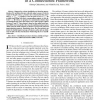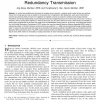124
click to vote
TPDS
2008
15 years 16 days ago
2008
This paper addresses fault-tolerant topology control in a heterogeneous wireless sensor network consisting of several resource-rich supernodes, used for data relaying, and a large...
120
click to vote
TNN
2008
15 years 16 days ago
2008
Abstract--Suppose for a given classification or function approximation (FA) problem data are collected using sensors. From the output of the th sensor, features are extracted, ther...
113
Voted
JCM
2007
15 years 16 days ago
2007
— Wireless communications is now completely pervasive, and already is used in many guises by people in everyday life. However until now, the information exchanged has been mainly...
105
Voted
TMC
2008
15 years 16 days ago
2008
We consider a scenario in which a wireless sensor network is formed by randomly deploying n sensors to measure some spatial function over a field, with the objective of computing a...
125
Voted
TMC
2008
15 years 16 days ago
2008
Key predistribution has been claimed to be the only viable approach for establishing shared keys between neighboring sensors after deployment for a typical sensor network. However,...
109
Voted
TMC
2008
15 years 16 days ago
2008
Sensor deployment is a critical issue because it affects the cost and detection capability of a wireless sensor network. In this work, we consider two related deployment problems: ...
91
Voted
TIT
2008
15 years 16 days ago
2008
One of the simplest sensor network models has one single underlying Gaussian source of interest, observed by many sensors, subject to independent Gaussian observation noise. The se...
117
click to vote
TDSC
2008
15 years 16 days ago
2008
In random key predistribution techniques for wireless sensor networks, a relatively small number of keys are randomly chosen from a large key pool and are loaded on the sensors pri...
126
click to vote
IS
2007
15 years 16 days ago
2007
Sensors are often employed to monitor continuously changing entities like locations of moving objects and temperature. The sensor readings are reported to a database system, and a...
108
Voted
TCS
2008
15 years 16 days ago
2008
Mobile sensors can self-deploy in a purely decentralized and distributed fashion, so to reach in finite time a state of static equilibrium in which they cover uniformly the enviro...





